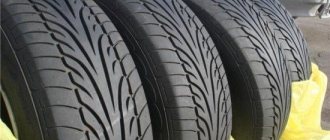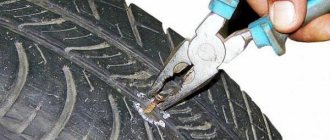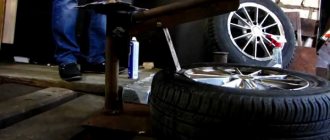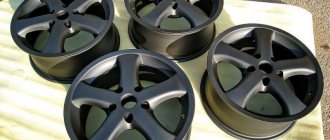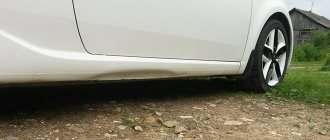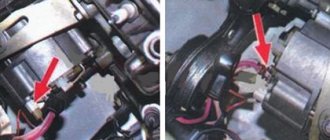Every good vehicle owner has two sets of tires: winter and summer. While one is in use, the other lies in storage in a secluded place, waiting for its season. Therefore, it turns out that each set is inactive for six months. Taking this into account, you should know how to properly store tires without rims and assembled ones, and what rules to follow to maintain their functionality at a high level.
Do not keep tires in the same room with chemicals such as solvents, fuels and lubricants, paints
Tire storage features
Before storing wheels, a thorough inspection should be carried out to ensure that they are suitable for further use. Each tire has wear indicators that help determine the remaining wear. In addition, it is worth examining them for cracks, bumps and hernias.
Important! Before removal, you must mark each tire with a white marker. This will allow you to easily install them in place in the new season and avoid premature wear.
Before storing car tires for seasonal storage, you need to thoroughly clean them of dirt and stones stuck in the tread, as this will accelerate the aging of the rubber and negatively affect its condition.
After complete drying, you need to place the wheels in textile covers made of breathable material, which will ensure air circulation. If they are not available, you can store the tires in plastic bags, but make small holes for ventilation so that condensation does not accumulate inside. It can cause wheel corrosion and rubber over-wetting.
General rules for storing wheels assembled and without rims:
- It is necessary to adhere to a certain temperature regime and avoid sudden changes.
- Tires should be no closer than 1 m from heating devices.
- Complete and non-rimmed wheels should be stored in different positions to avoid deformation.
- Every two months you should turn the wheels and change the fulcrum.
- Tires can be stored outdoors for no more than a month under a canopy or shelter that protects them from external factors.
- It is unacceptable to store wheels on a wet or frozen surface, otherwise deformation cannot be avoided.
- Do not rest tires on sharp objects.
- Do not place heavy objects on top of the wheels.
Preparing tires for seasonal storage
So, we washed, dried and treated the wheels. What's next? We take stickers, paper, tape, a felt-tip pen and mark each tire. For you they are all the same and it seems that you can swap places without looking and there will be no difference. But there is a difference for the car, especially if you have recently had a wheel alignment.
Everything is simple here: front right (FR), front left (RL), rear right (RR), rear left (RL). If the tires will be stored without rims, then the rubber must first be removed from the rims, which means that this issue needs to be resolved in advance by professionals - this service is done at any tire shop in 5 minutes.
Tire cleaning
Don't forget to wash the tires well to remove any dirt. The easiest and most convenient way to do this is in a contactless car wash under a strong stream of water with shampoo. If there is indelible dirt somewhere, scrub by hand with a stiff brush or rag.
Drying tires
We dry it without hesitation. It is easier to do this in the sun, but most of the moisture must be removed with a large rag.
Tire processing
If possible, treat the rubber with preservative compounds that will save it from premature wear - silicone grease will help you.
Packing tires, if necessary, in covers or bags
There is a small nuance here: these should be air-permeable bags or covers. Even if you wash off all the dirt from the rubber and wipe it dry, some moisture may remain, so you should not seal the tires, otherwise condensation will not be avoided.
If you store tires lying down (stacked)
If tires are stored on rims stacked on top of each other, be sure to reduce the pressure to 1.4-1.5 atm.
At what temperature can tires be stored?
According to existing standards, wheels can be stored at temperatures from -25 to +35 degrees and air humidity at 50-60%. At the same time, sudden jumps should not be allowed.
But it should be borne in mind that storing summer tires in the cold is not recommended, since low temperatures negatively affect their quality. In this case, it is worth maintaining a range from +5 to +35 degrees. Therefore, to store summer tires in winter, you need to select a heated room so that the conditions in it are as close as possible to operating conditions.
When storing winter tires, a significant drop in temperature is allowed, but before installing the wheels, they must be kept at positive temperatures. Ignoring this rule may cause tire deformation and rapid wear.
Despite the fact that winter and summer tires can be stored at elevated temperatures, it should be understood that direct exposure to sunlight has a detrimental effect on rubber. Ultraviolet radiation provokes the appearance of microcracks as a result of drying out, and this also weakens the strength of the tire and increases the likelihood of the tire bursting while driving.
Therefore, to properly store wheels, you need to maintain the temperature within +10... +25 degrees, excluding direct sunlight.
Why and how to use tire preservatives
Any rubber dries and cracks over time, even if it is just in storage. This is especially true for car tires, since the safety of driving a car critically depends on their condition. In addition, every car enthusiast wants to extend the life of a car tire, since rubber is not cheap. Therefore, using a preservative for storing tires also has a positive economic effect.
As a rule, tire treatment products are based on silicone oils . These compounds have a beneficial effect on rubber, not only creating a protective layer on their surface, but also softening it, that is, preventing it from tanning. This is especially true when it comes to a tire that is already quite old and/or worn out. Using a tire retreading product will increase its service life. You can process both winter and summer tires, including those with studs, with different tread depths and shapes, as well as tires of any diameter. Silicone for tire preservation works equally well on any rubber.
Please note that unlike tire cleaners, which cannot be applied to the tread, tire preservative formulations must be applied to the entire outer surface of the tire, including the portion that directly contacts the road surface.
How to properly store tires
Using a tire preservative makes sense especially if they are stored in unfavorable conditions. Thus, it is recommended to store car tires in a well-ventilated area where the relative humidity is within normal limits, about 50%...60%. As for the temperature, it should be about +10°...+25°C. Temperatures exceeding this range may negatively affect the condition of the tire after it is removed from storage. Therefore, if rubber is stored under conditions corresponding to a slight deviation from those specified, then it makes even more sense to treat it with a preservative before storing it for long-term storage.
Interestingly, tire preservatives are all the more interesting for tire service workers and owners of auto shops that sell automobile tires. So, these products can be used to treat tires that were not sold during the season. This will give their surface a marketable appearance even after long-term storage in a warehouse during the off-season. However, in this case it is better to buy concentrated products to save money.
As for the method of using tire preservatives, there is usually only one, and it consists in applying the product to the outer surface of the tire from the aerosol can in which it is sold. An aerosol can not only provides ease of use of the preservative, but also allows it to be applied to the surface to be treated more evenly and efficiently. Please note that before treatment, tires must be cleaned of dirt using water and a brush (the easiest way is to wash them under the pressure of water from a Karcher or similar device), and apply the preservative to a dry surface. At the same time, it is advisable to wash the discs as well. Applying the product to a dirty and/or wet tire will reduce the effectiveness of its use down to zero.
Also, before washing (if the tire is not very dirty), it is advisable to treat the surface of the tire with an alkaline (!!!) solvent and a brush.
In this case, as a result of a chemical reaction provoked by the solvent, foam will form. The washing process must be repeated until the foam stops being colored. After this, the solvent must be thoroughly rinsed off with plenty of water and the tire allowed to dry.
How to treat tires before storage
Tire treatment significantly extends service life
To preserve the quality of rubber, it must be pre-treated with a special aerosol, which is sold in car dealerships. The procedure should be carried out after the tires have been cleaned of dirt and dust, washed and dried.
The product should be applied in 2-3 layers, with a break between them to allow the previous one to dry. Upon completion of processing, each wheel must be placed in a case.
Advice! You need to use a preservative for storage taking into account the type of rubber and strictly according to the instructions.
Why is it so important to prepare tires for seasonal storage?
Even if you find the best place for storage - grandma's loggia, landscaped with monsteras, a storage room in the basement of a house, a friend's heated garage or an Attic, simply removing the wheels from the car and throwing it right off the road for six months will not work. There is too much risk of losing, that is, throwing in the trash, a new and good set of tires by the next season. In order to properly prepare your tires, you need to set aside a separate evening for this, which will certainly save you both tires and nerves.
Where can you store car wheels?
Storing wheels with or without rims in winter and summer must take into account the basic requirements. To do this, you can use various rooms:
- brick garage;
- glazed balcony;
- storage room;
- basement.
When choosing a location, you need to take into account that it should be dry, since an increased level of moisture negatively affects the quality of the rubber.
It is not recommended to use sheds, attics, or metal garages for storage. This is due to the fact that it is very difficult to maintain optimal conditions in them. An unglazed balcony or loggia is also not suitable for storage, since the sun, wind, moisture and frost will negatively affect the structure of the rubber. This can lead to wheel damage in just one season.
It is important that devices and equipment that emit steam, gas or ozone are not used indoors. It should also be taken into account that contact of rubber with copper and corrosive metals for a long time negatively affects its structure.
If it is not possible to independently ensure the correct storage of assembled wheels and without rims in the garage, you can use the services of tire fitting and car service centers. For this purpose, they have special warehouses with appropriate equipment. This service is paid, but guarantees the preservation of the quality of the rubber. The price for storing one set varies between 2500-3600 rubles.
When storing tires, you need to carefully study the conditions under which they are kept. All this must be spelled out in the contract, which will also stipulate the responsibility of the car service in the event of loss or damage to the wheels. To make sure that all conditions are met, it would be a good idea to take your own measurements in the room.
FAQ
Where to store tires in an apartment?
Car tires have a very strong and unpleasant smell, so storing them in an apartment will cause you a lot of inconvenience. In addition, according to fire safety rules, they consist of highly flammable substances, so they must be stored in special rooms.
What is the best way to store tires flat or inflated?
Wheels on rims must be kept inflated, and many experts recommend periodically checking the pressure and adjusting it if necessary. Tube wheels without discs are recommended to be lowered to 1.5 atmospheres.
Is there a difference in storing new tires from old ones?
There is only one difference - if the tire’s expiration date has passed, and it is 5-6 years, then storing the wheels simply does not make sense. After the expiration date, driving on such wheels will be simply dangerous.
How can tires be treated before storage?
To prepare tires for storage, there are specially designed silicone lubricants; they are sold in all car dealerships. Consult with the seller which lubricant is in greatest demand, and use it to preserve your rubber.
Does storing car tires on rims harm rubber?
Not only does it not harm, but it is also recommended. However, not everyone can afford two sets of wheels, which is why they have to be disassembled before storage.
Can tires be stored in bags?
Tires without rims can be placed in a plastic bag, but if you store wheels on rims, then when storing them in bags, you should not seal them tightly, but rather leave them slightly open. Then condensation will not spoil the disks. It is best to use special tire covers, which can be found at any auto store.
How to store wheels for a long period?
To preserve the tires, they need to create appropriate conditions. There is a GOST with rules for storing rubber, which we will write about below. In any case, it is recommended to periodically check the tires and turn them over if necessary.
How to properly store tires at home
It is not recommended to store tires in the house. The exception is the balcony, but for this the wheels need to create appropriate conditions, which we will discuss below.
At what temperature should tires be stored?
According to the rules, the temperature can vary over a fairly wide range from +35C to -35C.
How to store rubber so as not to crack?
For better preservation of rubber, it is necessary to observe the temperature regime and appropriate air humidity. Avoid exposing rubber to direct sunlight and chemicals. Keep away from heating devices.
In what position should the wheels be stored?
When storing wheels, it is important not only to choose a place and create conditions, but also to know how to properly position the tires. Many car owners do not attach due importance to this, mistakenly thinking that rubber can lose its quality only during operation. But in the absence of loads, tires can also be subject to deformation.
You can store wheels with or without rims. This is not of fundamental importance and depends purely on the personal preferences of the car owner and the availability of free space in the garage. But at the same time, you should figure out how to properly store tires - lying down or standing in both cases, and what to do is strictly prohibited.
In what position should tires be stored without rims?
Tires without rims must be stored vertically
When storing tires without rims, the usual methods cannot be used, otherwise it will not be possible to avoid deformation of tires of even the most expensive and high-quality brands. The best option is to place the tires vertically with support on a wall, rack or on each other. In this case, the rubber should be close, but without the possibility of compression.
Tires without rims should be stored in a garage subject to the following restrictions:
- you cannot hang rubber, as this will lead to deformation under the force of its own gravity;
- It is not recommended to stack them to avoid distortion of the shape and uneven tread wear.
In what position should tires and rims be stored?
Tires mounted on rims must not be stored in a standing position.
According to manufacturers' recommendations, it is best to store wheels with inflated rims. In this case, the possibility of moisture and dust getting on the inner surface of the tire is excluded. There is also no need to re-align the wheels every season, which greatly simplifies the replacement process.
To prevent deformation of the tread under weight, it is necessary to stack the wheels on top of each other in a stack of 2 pieces. It is important to turn over and swap the top and bottom tires every 1-2 months.
Winter and summer tires with discs can also be stored in a suspended state. To do this, you need to wrap the hook in fabric and thread it through the hole in the disk. In this vertical position, the tires can be stored until the next season, but they must be turned over once a month to avoid bending.
Important! When storing rubber with rims, you need to maintain the operating pressure inside the tire at 1 atm.
What to choose for caring for tires – silicone lubricant or tire dye?
Car owners often face the question: what is better to treat tires with silicone grease or rubber ink? Which option is more effective, cheaper and more convenient to use?
The effect of using silicone grease and inks of different quality. It is known that cheap tire ink does not have a serious effect on tires and is only suitable for decorative purposes. Silicone grease seems like a suitable option - it not only improves the appearance of the tires, but also fills microcracks and masks defects. In addition, the effect lasts longer than using cheap ink. So which is best for tires?
Tire dye actually does a worse job of caring for tires than silicone lubricant, but this only applies to cheap glycerin-based products. But for the production of expensive ink, silicone is used and the effect of use differs significantly.
The silicone-based lubricant is waterproof and creates a protective film on the tires that does not allow water and dirt to linger on the surface. This film also protects rubber from exposure to ultraviolet rays and makes its color more saturated due to slight refraction of sunlight. After treatment with such a lubricant, the tires begin to look like new, but this product also has a drawback - the effect is not long-lasting, just get your car in the rain or send it to the car wash, and the silicone lubricant will be completely washed off and you will need to carry out the treatment process again.
Silicone-based ink has a similar effect, but the effect lasts much longer. As an experiment, you can try treating one car wheel with this ink and the other with silicone grease to compare the result. Visually there will be no differences between the wheels, but after several washes or trips, the silicone grease will be almost completely washed off, but the ink will remain.
Comparison of cost and consumption of the product. Another parameter by which these two products can be compared is cost and how economically they can be used. Silicone grease and high-quality ink have different prices, the latter being more expensive. However, this disadvantage is compensated by the long-term effect of the ink and its minimal consumption. To treat the surface of the same wheel, it will require much less than lubricant. In addition, subsequent tire treatments will require a minimal amount of ink, since the product is not washed off the surface even after water or long trips. Silicone grease cannot boast of this property - after contact with water, it is completely washed off, which is why the wheels have to be reprocessed.
Bottom line. What's better? Therefore, the best option for tire care is a quality silicone-based tire ink. Silicone grease has a similar effect but does not last long, but is much better to use than cheap glycerin based inks.
Shelf life of car tires
Any tire, regardless of quality, manufacturer and cost, has a certain expiration date. If all standards for storage and operation of rubber are observed, it does not exceed six years, starting from the date of manufacture.
The duration of operation primarily depends on the quality of the rubber and the special softeners included in its composition. The degree of wear can be determined by visual inspection and by the elasticity of the material. At the end of their expiration date, tires become hard and cracks appear on them, making further use impossible.
Important! Wheels with obvious signs of deformation and wear cannot be used for their intended purpose, as this is dangerous to life.
It has been noticed that car tires that are not subjected to long-term storage can last much longer. This is due to the fact that rubber softeners perform their function only under constant loads, and therefore the material does not lose its elasticity. To extend the shelf life of tires, it is recommended to treat the rubber with special products that create a protective layer on the surface before storing them.
Advice! Summer tires cannot be stored in the cold, since this rubber does not contain special components that can withstand low temperatures.
The best place to store tires in the off-season
It should be remembered that even though tires are changed once every six months, when stored in the same place they will have to survive both the hot summer and the rainy autumn. Based on the above conditions, we can say that it is best to allocate space for storage in a brick garage, a dry and clean basement, a storage room in an apartment, or turn to the services of specialized warehouses, of which there are more and more recently.
If the garage is metal, then you can store tires in it only in winter, and then provided that it is not located under the shade of trees. The same applies to attics, sheds and other utility rooms. A balcony, especially if there is no glazing on it, is far from the most optimal place to store rubber, regardless of the time of year.
It is prohibited to store tires outside, even if you build a shed. During the six months that the tires spend outdoors, they will be negatively affected by everything that is contraindicated for them - moisture, ultraviolet radiation, pollution and temperature changes.
Responsible storage of tires during the off-season
Relatively recently, service stations began to massively offer a new service - responsible storage of tires during the off-season. This service is quite in demand by car owners, but in order for the “preservation” of tires to be of truly high quality, it is necessary to create special conditions for this, which not all small companies can afford.
But if you are attracted by this offer, then carefully study the storage agreement, in which be sure to check that the conditions in the warehouse (microclimate, etc.) are indicated, as well as the liability that the organization will bear in the event of damage or loss of your property. Ask how the condition of tires is assessed upon delivery/receipt, as well as how losses will be compensated if something happens.
If, upon arrival at the “tire hotel”, you are offered not to bother and just hand over the tires according to the receipt, then it would be wiser to refuse the services of such a company. In turn, a long and confusing agreement made according to a template should also cause caution, because often agreements stretched out to five pages with a lot of sub-clauses in small print are designed to hide under a layer of unnecessary text “escape routes” for the company, which, if something happens, will help them avoid liability.
If there are no “dark spots” in the agreement, then you can go to the warehouse inspection. Normally, a thermometer and a hydrometer should be located inside the room. If you see 85-90% on the last device, then you can immediately pick up your tires and leave. All electric heaters dry out the air, and therefore their presence in the “tire hotel” is undesirable.
All these nuances require special attention, because there is a risk that, having arrived at the warehouse for replacement tires, the owner may be faced with the fact that he will urgently have to purchase new ones.
Tire conditioner
Calculator for converting pressure in bar to MPa, kgf and psi
Online converter to convert pressure in megapascals (mPa) to kilograms (kgf cm2), bar, pound force (psi) and atmosphere
Tire conditioner is a special product designed to treat the outer surface of the tire before sending it for preservation. Its purpose is to maintain the elasticity of the surface, prevent aging and cracking of the rubber, and also protect it from harmful factors such as ultraviolet radiation and high humidity.
Many car enthusiasts know that when storing rubber it is necessary to adhere to certain rules, but not everyone is aware of the availability of special chemicals for preserving tires. Such products are called differently - tire preservative, tire rubber conditioner, tire protector, and so on. Currently, they are gaining increasing popularity due to the fact that with their help you can significantly increase the service life of car tires, and therefore save money. There are a variety of tire preservatives available on store shelves, but your choice must be made based on additional information. The following material presents a non-commercial rating of popular preservatives used by both domestic car enthusiasts and their foreign colleagues.
| Product name | Brief description and features of use | Package volume, ml/mg | Price as of winter 2018/2019, rubles |
| Tire cleaner Hi-Gear | A complex product that is a conditioner-cleaner and preservative for tires. Perfectly protects the rubber surface of car tires. It can be used both for regular treatment of tires and for treating their surfaces before storing them for long-term storage in the off-season. It contains an element called FadeStop, the task of which is to reliably protect rubber from the harmful effects of ultraviolet radiation. | 454 | 500 |
| Spray conditioner for the care of rubber and plastic products Verylube | The product can be used on rubber and plastic surfaces. For example, it can be used to treat a “torpedo” to protect it from ultraviolet radiation. Perfectly protects tire rubber from harmful factors during off-season storage. There are many positive reviews about this preservative on the Internet. | 320 ml; 500 ml. | 350 rubles; 380 rubles. |
| Preservative product for caring for plastic and rubber Koch Chemie Gummi- KunstStoff | The product is a universal product that can be used to treat rubber elements (for example, car door seals, rubber bands on windshield wipers and other rubber parts), exterior plastic and vinyl parts. It is sold in the form of a liquid, so it must be applied using a rag or brush. In this case, you need to process the tires twice - clockwise and counterclockwise. | 1 liter | 800 |
| Preservative concentrate for tires Toal-Mix | This product is most likely suitable for use by auto repairmen and tire sellers. Sold as a concentrate in a liquid state. After treatment, the tire must be wrapped in cellophane film before being removed for storage. The preservative is applied using a spray bottle or a paint brush. The treated tire can be stored for up to 5 years! | 1 liter; 5 liters. | 200 rubles; 800 rubles. |
How else can you treat a tire?
If for some reason you do not want or cannot buy a tire preservative produced specifically for these purposes, then you can use similar products that have a similar effect. As mentioned above, most tire preservatives are based on silicone oils. Accordingly, tires can be treated with regular silicone grease before storage. This universal product is used to treat a wide variety of surfaces and things, including car tires.
An example of packaging silicone lubricant in an aerosol can
Like factory-made tire preservatives, in most cases silicone lubricant is sold in packaging in the form of an aerosol can. However, in rare cases you can find this product on sale in liquid form. In this case, you can do it in two ways. The first is to thoroughly coat the entire outer surface of the tire with the mentioned lubricant using a rag or napkin. Naturally, this is quite a labor-intensive and lengthy task. Therefore, the second option is to place some silicone lubricant in a hand-held spray bottle and use it to apply the lubricant to the rubber surface like an aerosol can. However, please note that not all lubricants can be placed in a spray bottle. If it is very dense and/or sticky, it can simply clog the membrane of the spray bottle. Therefore, the optimal solution in this situation would be to buy silicone lubricant in a can, especially since nowadays this is not a problem, and the range of products on sale is quite wide, and the price of such lubricant is low.
Some car enthusiasts are confused by the fact that the silicone grease in the cans contains a small amount of solvent. It is necessary so that you can spray the lubricant from the bottle without problems, as well as apply it evenly. In fact, after application, the solvent evaporates from the surface within a maximum of half an hour (usually even faster), so it does not cause any harm to car rubber.
In some cases, instead of silicone grease for treatment, you can use tire black . Just before applying, you must carefully read the instructions; as a rule, it must be applied to thoroughly washed and dry rubber. And not for treating the contact surface, since then the grip characteristics of the tires will deteriorate. As for specific brands, the range of these products is currently very wide, and it makes no sense to recommend any of them. In any auto store you will find a wide selection of tire ink.
You can also use natural liquid silicone . It is used in everyday life and industry for lubricating rubber, rubber gaskets, treadmills, molds, and for blackening wheels and bumpers. Physically, it is a thick, transparent, colorless (less often with the addition of dye) liquid slightly heavier than water (density about 1.1...1.2 kilograms per cubic meter). It can be found on sale in canisters (for example, five-liter) in various automotive, household or construction stores. Apply liquid silicone to a clean, dry surface using a brush (paint brush) or rag.
Conclusion
Treating car tires with special preservatives before storing them is a very useful procedure that will not only protect the rubber from premature aging and cracking, but will also significantly extend its service life. Therefore, the use of the mentioned preservatives is recommended for all car enthusiasts who value not only safe driving, but also savings on the maintenance of car components. As for the choice of one or another product, it must be done not only based on the ratio of price, quality and effectiveness of use, but also on the logistics component. Thus, different preservatives may be available in different regions of the country.
Source



